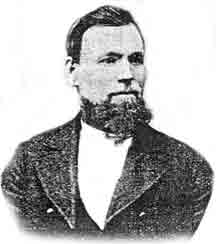The Institution.
51 King Street, Glasgow.

Mr Campbell. 1893.
Mr Campbell was a native of Armagh and came to Scotland in 1863, finding work where ever he could. For eighteen years he was in the employment of Thomas Ellis, Coatbridge, of the British Iron Works, as a contractor. He had been twelve years associated with the spirit trade, but left the management of the business almost entirely to Mrs Campbell. The Institution was conducted by Mrs Campbell with an assistant barman.
The Institution was situated in King Street, city centre, it was a favourite haunt of the old societies in Glasgow. The building of which it forms the ground floor, was old and time-worn. The tavern had two entrances, one from Kind Street through a narrow close, the other from the lane which bounds the western side of the Britannia Music Hall. On both sides the locality was insalubrious and inhabited by the rougher element of Glasgow's population and when a stranger visited, he was surprised by the appearance of the place and the persons who patronised it, so out of harmony were they with the external surroundings.
Inside the Institution was a model of neatness, everything suggestive of comfort, the sitting-rooms cosy with a fire blazing in the grates and it was nothing unusual to find even a Glasgow Bailie or a Glasgow Minister enjoying a pipe, sipping stout or ale out of silver tankards, or consuming a snack of scallops or brandered steak.
Mrs Anderson was a most genial host, full of lore about the place and a link that connects Glasgow with that of two hundred years. Her father Mr Fisken, was the proprietor of the White Hart Hotel and the carrier quarters, situated where the Bazzar was located. The White Hart and carriers quarters were historical places; here, too, the old Glasgow Radicals met, and on one occasion Thomas Muir, the brilliant Glasgow advocate and one of the pioneers and martyrs of Scottish democracy, addressed a meeting of sympathisers of the great French Revolution. Mr Fisken ran coaches from Glasgow to Balfron and had the cleansing of the city before Drummond was entrusted with that duty.
Mrs Anderson still had in 1891, nine silver tankards presented by the students of the Old College to Anderston, one of the proprietors of the place, in recognition of the generous hospitality extended to the boisterous graduates who frequented the tavern. At that time the professors and students met regularly here, and here nightly story followed story and the roof rang with merriment.
On of the most interesting things about the Institution was a ring in a hugh stone at the King Street entrance, to which Sir Walter Scott was in the habit of fixing his horse while refreshing himself in the tavern. Sir Walter Scott, as it was said, when he visited Glasgow on legal business patronised The Institution, where he usually met other congenial cronies connected with his profession. Another feature in the Institution is what is known as the "Wishing Stone," near the bar. The story goes that persons sitting underneath this stone, which projects slightly from the wall, were usually awarded with what they desired. The custom has fallen into disuse, but sometimes it is still resorted to by the more youthful of patrons.
There has always been a dispute as to the oldest tavern in Glasgow, the Institution in King Street and the Waverley in the Old Wynd were just two of them.
End.
